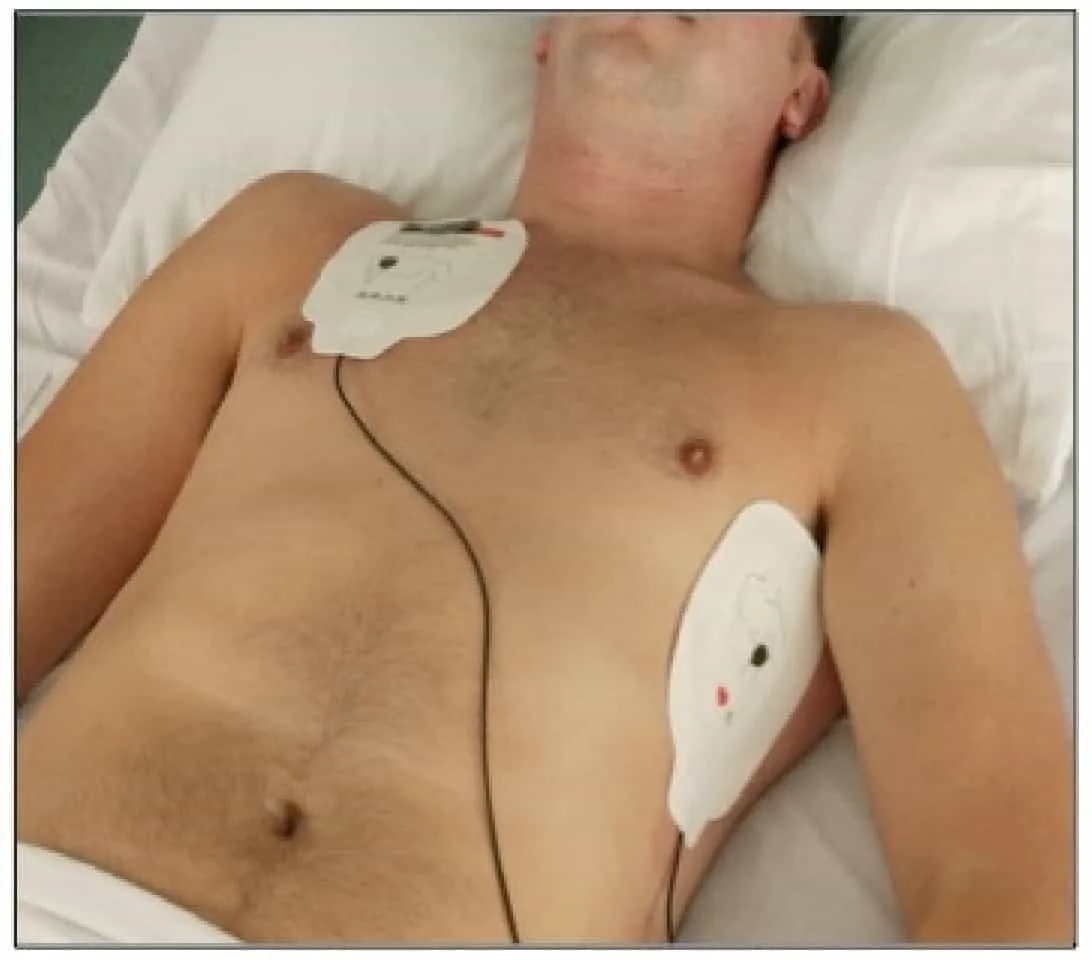ANZCOR Guideline 7 - Automated External Defibrillation in Basic Life Support

Summary
The importance of defibrillation has been well established as part of overall resuscitation, along with effective cardiopulmonary resuscitation (CPR). An Automated External Defibrillator (AED) must only be used for persons who are unresponsive and not breathing normally.
With cardiac arrest, time to defibrillation is a key factor that influences a person’s chance of survival. A defibrillator should be applied to the person who is unresponsive and not breathing normally as soon as it becomes available so that a shock can be delivered if necessary.
Who does this guideline apply to?
This guideline applies to all persons who are unresponsive and not breathing normally.
Who is the audience for this guideline?
This guideline is for use by bystanders, first aiders or first aid providers, first responders and health professionals.
Recommendations
The Australian and New Zealand Committee on Resuscitation (ANZCOR) makes the following recommendations:
- For all who are unresponsive and not breathing normally, chest compressions should be commenced immediately and continued until an AED is applied. The AED should be applied as soon as it becomes available so that a shock can be delivered if necessary.
- The use of publicly accessible AEDs is recommended to increase survival rates in those who have cardiac arrest.
- Pads are to be placed to ensure that a shock is delivered on an axis through the heart. Typical pad placement in adults and children is the anterior-lateral position.
- Although AEDs are extremely safe, rescuers should take care not to touch a person during shock delivery.
Guideline
1 Background
The importance of defibrillation has been well established as part of overall resuscitation, along with effective cardiopulmonary resuscitation (CPR). An Automated External Defibrillator (AED) must only be used for persons who are unresponsive and not breathing normally. CPR must be continued until the AED is turned on and pads attached. The rescuer should then follow the AED prompts.
The time to defibrillation is a key factor that influences survival. For every minute defibrillation is delayed, there is approximately 10% reduction in survival if the victim is in cardiac arrest due to Ventricular Fibrillation (VF).1 CPR alone will not save a person in VF. Hence a defibrillator should be applied to the person in need as soon as it becomes available so that a shock can be delivered if necessary.
The development of AEDs has made defibrillation part of basic life support. AEDs can accurately identify the cardiac rhythm as ‘shockable’ or ‘non shockable’.
2 Which rescuers should use an AED?
AED use should not be restricted to trained personnel. Allowing the use of AEDs by individuals without prior formal training can be beneficial and may be life saving. Since even brief training improves performance (e.g. speed of use, correct pad placement), it is recommended that training in the use of AEDs (as a part of BLS) be provided.2,3 [Good practice statement]
The use of AEDs by trained lay and professional responders is recommended to increase survival rates in those who have cardiac arrest.2
3 Public Access to AEDs
ANZCOR recommends the implementation of public access AED programs for out-of-hospital cardiac arrest.4,5 [2020 CoSTR, strong recommendation, low-certainty evidence] Issues such as early detection of cardiac arrest, optimising AED availability, AED signage, novel delivery methods, public awareness, device registration, mobile apps for AED retrieval and personal access defibrillation should be considered as part of all PAD programs.4,5 [Good practice statement] ANZCOR suggests that AED signage is consistent with international recommendations. [Good practice statement]
Deployment of home AEDs for high-risk individuals who do not have an implantable cardioverter defibrillator (ICD) is safe and feasible, and may be considered on an individual basis, but has not been shown to change overall survival rates.2 [Good practice statement] Use of AEDs in public settings (airports, casinos, sports facilities, etc.) where witnessed cardiac arrest is likely to occur can be useful if an effective response plan is in place.2 An AED can and should be used on pregnant women who are in cardiac arrest.
Use of AEDs is reasonable to facilitate early defibrillation in hospitals.2 Studies to date have shown AEDs are effective in decreasing the time to first defibrillation during in-hospital cardiac arrest.2
4 Pad Placement
4.1 Pad placement - Adults
Effective pad placement ensures that a shock is delivered on an axis through the heart. Place pads on the exposed chest in an anterior-lateral position: one pad slightly below the collar bone on the person’s right chest and one pad on the person’s left side below the arm pit (Figure 1). Acceptable alternatives are the anterior-posterior position, where one pad is placed on the upper back between the shoulder blades and the other on the front of the chest (slightly to the left, if possible); and apex-posterior.1,4
In large-breasted individuals it is reasonable to place the left electrode pad lateral to the left breast to avoid breast tissue.1,4,5 All pads have a diagram on the outer covering demonstrating the area suitable for pad placement.1 [Good practice statement] Pad to skin contact is important for successful defibrillation. Rescuers may need to remove moisture or excessive chest hair prior to the application of pads but emphasis must be on minimizing delays in shock delivery.1 [Good practice statement]

Figure 1: Anterior-lateral pad placement
Avoid placing pads over implantable devices. If there is an implantable medical device the defibrillator pad should be placed at least 8cm from the device.1 Do not place AED electrode pads directly on top of a medication patch because the patch may block delivery of energy from the electrode pad to the heart and may cause small burns to the skin. Remove medication patches and wipe the area before attaching the electrode pad.1
4.2 Pad placement - Children and Infants
Standard adult AEDs and pads are suitable for use in children older than 8 years. Ideally, for those under 8 years (including infants < 1 year) paediatric pads and an AED with a paediatric capability should be used (see guideline 12.1). These pads also are placed as per the adult and the pads and come with a diagram of where on the chest they should be placed.6
If the AED does not have a paediatric mode or paediatric pads then it is reasonable to proceed with standard adult AED pads.2 Ensure the pads do not touch each other on the child’s chest.6 Apply the pad firmly to the bare chest in the anterior-lateral position as shown for adults in Figure 1. If the pads are too large (a particular risk in younger children and infants) and there is a danger of pad-to-pad arcing, use the front-back position (antero-posterior): one pad placed on the upper back (between the shoulder blades) and the other pad on the front of the chest, if possible slightly to the left.7
5 Defibrillation Safety
Rescuers should follow the prompts: care should be taken not to touch the person during shock delivery. There are no reports of harm to rescuers from attempting defibrillation in wet environments.2 [Good practice statement] In the presence of oxygen, there are no case reports of fires caused by sparking when shocks were delivered using adhesive pads.2 [Good practice statement]
References
- Sunde K, Jacobs I, Deakin CD, et al. Part 6: Defibrillation: 2010 International Consensus on Cardiopulmonary Resuscitation and Emergency Cardiovascular Care Science with Treatment Recommendations. Resuscitation 201 0; 81 (1): e71-e85.
- Soar J, Mancini ME, Bhanji F, et al. Part 12: Education, implementation, and teams: 2010 International Consensus on Cardiopulmonary Resuscitation and Emergency Cardiovascular Care Science with Treatment Recommendations. Resuscitation 2010; 81 (1): e288-e330.
- Finn JC, Bhanji F, Lockey A, et al. Part 8: Education, implementation, and teams 2015 International Consensus on Cardiopulmonary Resuscitation and Emergency Cardiovascular Care Science With Treatment Recommendations. Resuscitation 2015; 95 : e203-e24.
- Olasveengen TM, Mancini ME, Perkins GD, et al. Adult Basic Life Support: 2020 International Consensus on Cardiopulmonary Resuscitation and Emergency Cardiovascular Care Science With Treatment Recommendations. Circulation 2020; 142 (16_suppl_1): S41-S91.
- Olasveengen TM, Mancini ME, Perkins GD, et al. Adult Basic Life Support: International Consensus on Cardiopulmonary Resuscitation and Emergency Cardiovascular Care Science With Treatment Recommendations. Resuscitation 2020; 156 : A35- A79.
- de Caen AR, Kleinman ME, Chameides L, et al. Part 10: Paediatric basic and advanced life support: 2010 International Consensus on Cardiopulmonary Resuscitation and Emergency Cardiovascular Care Science with Treatment Recommendations. Resuscitation 2010; 81 (1): e213- e59.
- Biarent D, Bingham R, Eich C, et al. European Resuscitation Council Guidelines for Resuscitation 2010 Section 6. Paediatric life support. Resuscitation 2010; 81 (10): 1364-88.
Further Reading
-
ANZCOR Guideline 11.4 Electrical Therapy for Adult Advanced Life Support
-
ANZCOR Guideline 12.6 Techniques in Paediatric Advanced Life Support
-
Search date/s: ILCOR literature search details and dates are available on the CoSTR page of the ILCOR website (https://costr.ilcor.org) and the relevant CoSTR documents:
- Automated External Defibrillator use in Drowning (BLS 856):? Scoping Review https://costr.ilcor.org/document/bls-856-automated-external- defibrillator-use-in-drowning-aed-use-tf-scoping-review
- CPR Prior to Defibrillation (BLS): Systematic Review https://costr.ilcor.org/document/cpr-prior-to-defibrillation-tfsr-costr
- Pad Size, Orientation and Placement (BLS): Scoping Review https://costr.ilcor.org/document/pad-size-orientation-and- placement - scoping-review
-
Questions/PICOs: Are described in the CoSTR documents (https://costr.ilcor.org)
-
Method: Mixed methods including ARC NHMRC methodology before 2017 and ILCOR GRADE methodology described in ILCOR publications since 2017.
-
Principal reviewers: Julie Considine, Hugh Grantham
-
Approved: April 2021
-
Guideline superseded: January 2016
